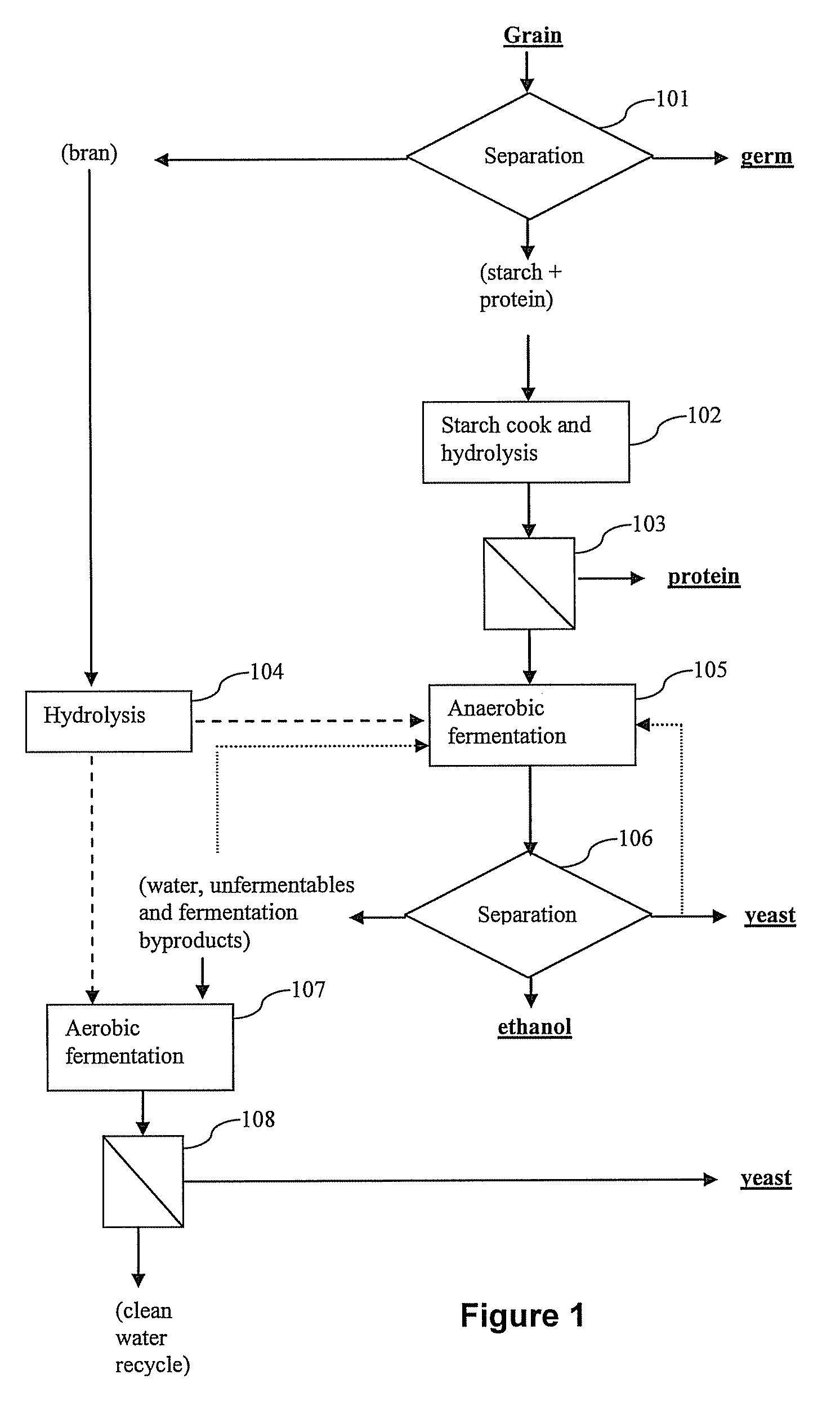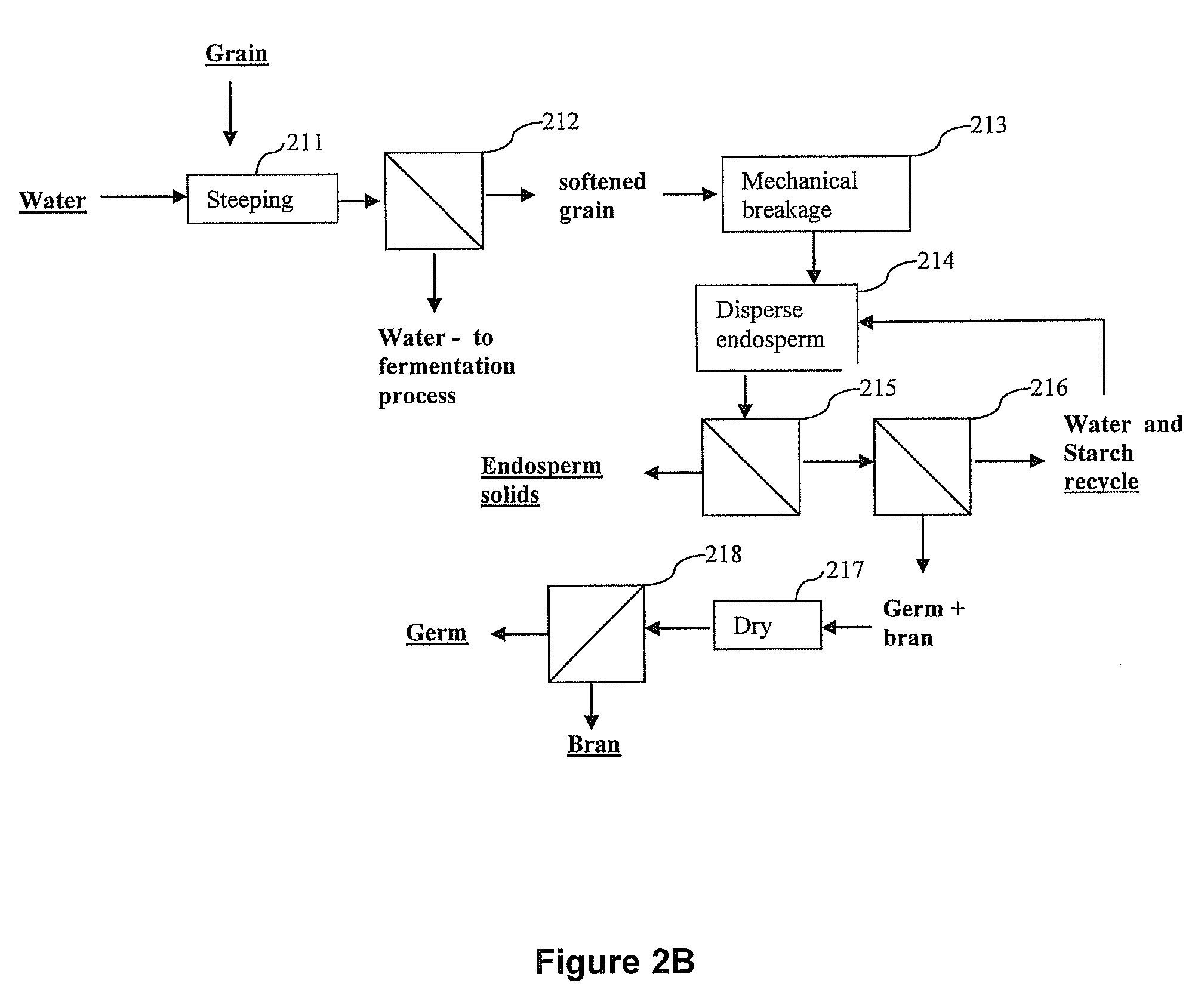Corn fractionation method
a fractionation method and corn technology, applied in the field of corn fractionation method, can solve the problems of reducing the unit cost of yeast harvest, contributing to air pollution, and inhibiting fermentation
- Summary
- Abstract
- Description
- Claims
- Application Information
AI Technical Summary
Benefits of technology
Problems solved by technology
Method used
Image
Examples
example 1
[0059]Enzymatic disruption of endosperm in cracked corn. Cracked corn is a commercial product, the coarsest grade of roller-milled corn. It comprises large fragments up to one-half the original kernel in size. Samples of approximately 15 g cracked corn were weighed in pared beakers, then enzyme mixtures in acetate buffer were added in volume sufficient to keep the corn immersed as it took up water. The beakers were weighed again, covered first with nylon net screens and then with foil and heated 24 h in a 50° C. bath. Periodically, the supernatant was decanted through the mesh to measure water uptake and solids release, expressed as brix of the suspension, and then returned to the beaker. After 24 hours, samples were extracted with an additional portion of water, which extracted little extra density. The solids were shaken vigorously with the combined extracts in glass jars, and the liquid phase was decanted through a nylon let screen and allowed to settle in a separate jar. The sup...
example 2
[0063]A larger-scale experiment employed approximately 210 g samples digested with 500 ul of stock Amano hemicellulase, 150 ul Multifect XL, and 150 ul Clarex ML and in 10 ml 83 mM acetate buffer pH 4.8 or 5.6 in a total of 149 ml liquid. Samples were incubated at 50° C. for 21 h total, with 30 ml additional water added at 225 min; All water was absorbed by 18 h. 200 ml additional water were added to cover and after 3 h further incubation the samples were dispersed by vigorous shaking. Samples were filtered through nylon net and the solids were re-extracted twice by further shaking with water. And rinsed a further 3×. The screenings stained only lightly for starch, with the pH 4.8 sample lighter than the 5.6 sample. The pooled sediments from the extracts and rinses, which resembled a butterscotch milkshake in color and consistency, were washed by decantation with 400 ml water. Samples of the screenings and the pooled, rinsed sediment were dried and weighed, and the remainder of each...
example 3
[0067]The following description of a 25 kg debranning run and its results employed a jacketed, variable-speed, single-ribbon mixer of about 3 ft3 capacity (Readco, York, Pa.). It was fitted with a stainless steel lid and o-ring seal, permitting it to be pressurized to 15 psi. The lid was fitted with a pressure gauge, rupture disk, safety valve, a thermocouple projecting into the headspace, a two inch ball valve with funnel for additions, and a ¼″ ball valve for manual pressure release. A drilled-pipe spray bar was fitted through a side port and connected through an L-pattern ball valve so that it could be used to supply steam directly into the headspace or spray streams of water or base solution onto the corn as it was mixed. This spray bar could also be turned to wash down the sides of the mixer. The bottom of the mixer had a four inch ball valve to discharge product and a thermocouple port so fitted that the thermocouple could be inserted into the mass of product with the mixer st...
PUM
| Property | Measurement | Unit |
|---|---|---|
| particle size | aaaaa | aaaaa |
| particle size | aaaaa | aaaaa |
| particle size | aaaaa | aaaaa |
Abstract
Description
Claims
Application Information
 Login to View More
Login to View More - R&D
- Intellectual Property
- Life Sciences
- Materials
- Tech Scout
- Unparalleled Data Quality
- Higher Quality Content
- 60% Fewer Hallucinations
Browse by: Latest US Patents, China's latest patents, Technical Efficacy Thesaurus, Application Domain, Technology Topic, Popular Technical Reports.
© 2025 PatSnap. All rights reserved.Legal|Privacy policy|Modern Slavery Act Transparency Statement|Sitemap|About US| Contact US: help@patsnap.com



